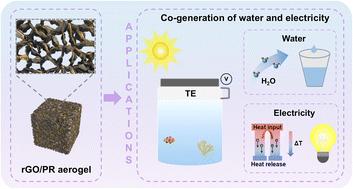一种坚固稳定的酚醛树脂交联石墨烯气凝胶,用于高效的太阳能驱动蒸汽热电联产
IF 9.5
2区 材料科学
Q1 CHEMISTRY, PHYSICAL
引用次数: 0
摘要
新兴的太阳能蒸汽发电(SSG)技术为从太阳能驱动的海水蒸发中生产淡水提供了一个有前途的策略。同时,SSG系统运行过程中的余热可以进一步用于发电,实现水电热电联产。从材料的角度来看,氧化石墨烯(GO)具有广泛的光吸收性、优异的亲水性和高度的结构可调性,在SSG应用中显示出巨大的潜力。然而,目前最先进的氧化石墨烯基SSG材料存在力学性能低、蒸发效率低、稳定性差等一系列技术问题。本研究以酚醛树脂(PR)为交联剂,组装了三维多孔氧化石墨烯基气凝胶;在此基础上,研制了一种坚固稳定的还原氧化石墨烯/酚醛树脂(rGO/PR)气凝胶,该气凝胶具有高效的太阳能吸收和水输送性能,以及优异的弹性和耐腐蚀性。此外,在一次太阳照射下,气凝胶同时实现了2.64 kg m−2 h−1的高水分蒸发速率和0.987 W m−2的异常发电密度,超过了大多数石墨烯基材料的性能。高效的热电联产能力以及出色的气凝胶稳定性为太阳能水处理和协同能量转换提供了一种变革性的解决方案。本文章由计算机程序翻译,如有差异,请以英文原文为准。

A robust and stable phenolic resin-crosslinked graphene aerogel for efficient solar-driven steam-power co-generation
The emerging solar steam generation (SSG) technology offers a promising strategy for producing fresh water from the solar-driven evaporation of seawater. Meanwhile, excess heat during the operation of SSG systems can be further used to generate electricity, realizing the co-generation of water and electricity. From the materials perspective, graphene oxide (GO) has demonstrated significant potential in SSG applications for its broad light absorption, excellent hydrophilicity, and high structural tunability. However, state-of-the-art GO-based SSG materials suffer from a series of technical issues including low mechanical performance, low evaporation efficiency, poor stability, etc. In this study, a three-dimensional porous GO-based aerogel is assembled by using phenolic resin (PR) as the crosslinking agent; thereafter, a robust and stable reduced graphene oxide/phenolic resin (rGO/PR) aerogel is developed, which features efficient solar absorption and water transport properties, along with excellent elasticity and corrosion resistance. Moreover, the aerogel simultaneously achieves a high water evaporation rate of 2.64 kg m−2 h−1 and an exceptional electricity generation density of 0.987 W m−2 under one sun irradiation, surpassing the performance of most graphene-based materials. The efficient co-generation capability together with the outstanding stability of the aerogel offers a transformative solution for solar-powered water treatment and synergistic energy conversion.
求助全文
通过发布文献求助,成功后即可免费获取论文全文。
去求助
来源期刊

Journal of Materials Chemistry A
CHEMISTRY, PHYSICAL-ENERGY & FUELS
CiteScore
19.50
自引率
5.00%
发文量
1892
审稿时长
1.5 months
期刊介绍:
The Journal of Materials Chemistry A, B & C covers a wide range of high-quality studies in the field of materials chemistry, with each section focusing on specific applications of the materials studied. Journal of Materials Chemistry A emphasizes applications in energy and sustainability, including topics such as artificial photosynthesis, batteries, and fuel cells. Journal of Materials Chemistry B focuses on applications in biology and medicine, while Journal of Materials Chemistry C covers applications in optical, magnetic, and electronic devices. Example topic areas within the scope of Journal of Materials Chemistry A include catalysis, green/sustainable materials, sensors, and water treatment, among others.
 求助内容:
求助内容: 应助结果提醒方式:
应助结果提醒方式:


